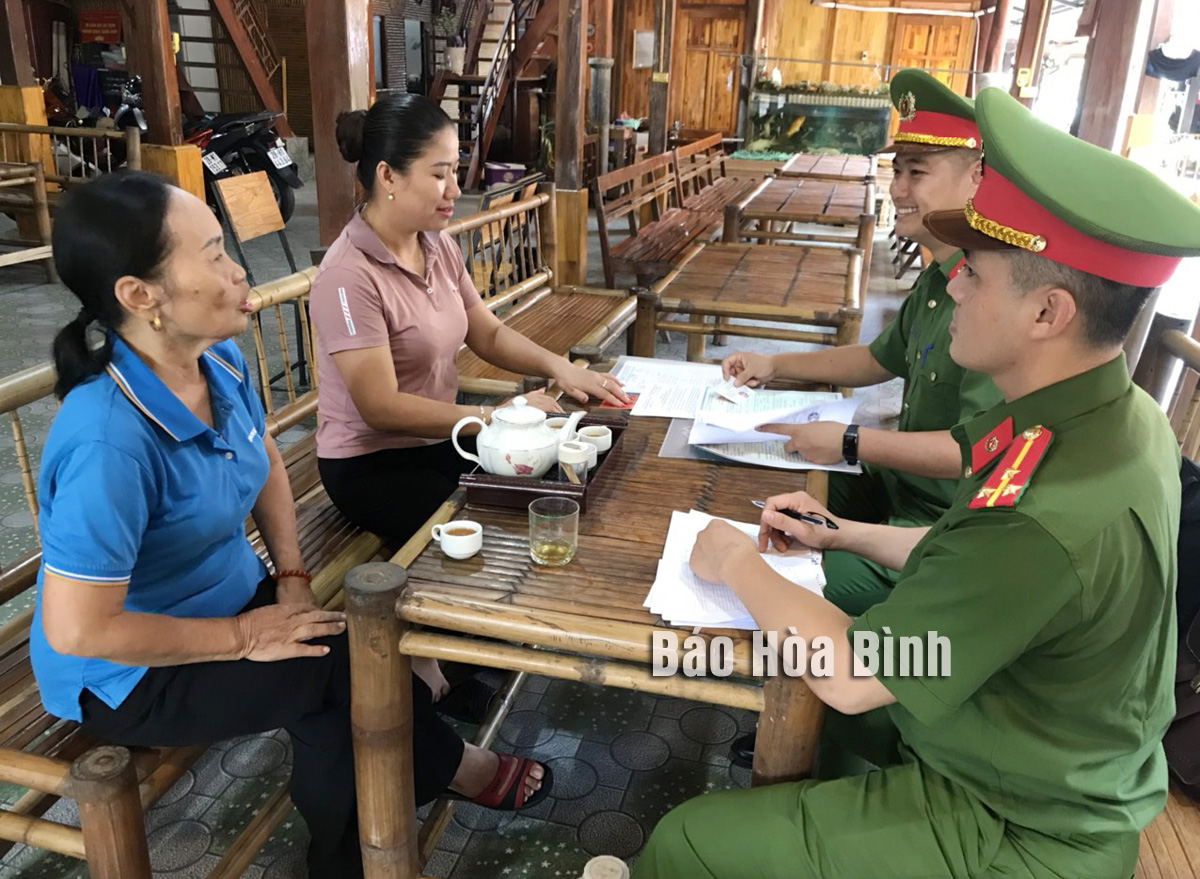
Mai Chau district has firmly established itself as a standout destination on Vietnam’s tourism map, attracting both domestic and international visitors with its breathtaking landscapes, rich ethnic culture, and warm hospitality. However, beyond its natural and cultural charm, a secure and well-managed tourism environment has added to Mai Chau’s appeal.
Police of Chieng Chau commune disseminate
regulations on lodging management and security for accommodation service
providers in Lac Village.
Chieng Chau commune, home to the renowned Lac Village,
is considered the tourism hub of Mai Chau district, welcoming hundreds of
thousands of visitors each year. According to Captain Nguyen Tuan Anh, deputy
chief of the Chieng Chau public security division, the locality is home to 103
accommodation establishments, with 86 under the police's direct managemnent.
Thanks to effective public security measures,
including community engagement in the "All People Protect the Fatherland's
Security" movement, Chieng Chau has maintained an exemplary track record in
public order and tourism safety. From 2024 to March 2025, the commune recorded
no legal violations. Authorities conducted 173 patrols to guarantee security.
Moreover, examination and communications have been boosted to ensure all
lodging businesses strictly adhere to guest registration rules. In particular,
grassroots security groups were set up in all the five villages, playing an
active role in working with police to safeguard local security.
Besides Chieng Chau, Hang Kia and Pa Co
communes, home to Mong ethnic communities, have also emerged as tourism magnets
in Hoa Binh province and the northwestern region. Here, local police have
properly advised the local Party committees and administrations about the state
management of security and order while bringing into play the public's role in
ensuring security.
Captain Vang A Hua, deputy head of the Hang Kia
public security division, said the commune has paid great attention to tourism
safety. With a good grasp of the local situation, police have dealt with
violations in a timely manner.
Currently, there are 146 accommodation
facilities in Mai Chau, including 12 hotels, 28 guesthouses, and 103 homestays,
offering a total of 555 rooms. Additionally, an eco-friendly transport
cooperative operates a fleet of 30 electric vehicles to enhance tourist
mobility.
The district features seven community-based
tourism sites, namely Lac, Buoc, Van, Pom Coong, Hich, Pa Co, and Hang Kia
villages. Tourism has not only contributed to local employment and income
improvement but also played a crucial role in cultural preservation. Luxury
resorts, including Avana Resort, Mai Chau Lodge, Mai Chau Ecolodge, Ba Khan
Village Resort, and Mai Chau Hideaway Resort, have further enriched the
district’s tourism offerings, attracting high-spending travellers and
increasing overall tourism revenue.
In 2024, Mai Chau welcomed approximately 773,230
visitors, reflecting a 17.74% growth rate. This included 224,795 international
tourists and 548,435 domestic visitors, generating an estimated 927.876 billion
VND in tourism revenue, a 37.88% increase from the previous year. The positive
momentum continued into early 2025, with tens of thousands of domestic and
international tourists coming to Mai Chau in the first quarter alone.
Hoang Duc Minh, Vice Chairman of the Mai Chau
district People's Committee, said ensuring tourism security and public order
remains a top priority. Security and stability have enabled Mai Chau to
successfully host prestigious cultural and sports events, further elevating its
tourism reputation. Recent highlights include the Vietnam Ultra Marathon 2024,
attracting over 2,200 athletes from 38 countries; the Hanoi–Mai Chau leg of the
Dien Bien Phu Cycling Race, featuring hundreds of national and international
cyclists.
Hoa Binh province is undergoing a dynamic transformation amid Vietnam’s national digital transition. Building on Poliburo’s Resolution No. 57-NQ/TW on breakthroughs in science, technology, innovation, and national digital transformation, the province has rolled out a wide range of practical action plans. A standout initiative is the "Digital Literacy for All” movement, an effort to ensure that no one is left behind in the digital era.
Hoa Binh province is undergoing a dynamic transformation in the wake of the national digital transformation movement. Building on Resolution No. 57-NQ/TW of the Politburo on breakthroughs in science, technology, innovation, and national digital transformation, the province has implemented a wide range of practical action plans. A standout initiative is the "Digital Literacy for All” movement ambitious effort to ensure that no one is left behind in the digital age.
With a spirit of unity and proactive problem-solving, the Party Committee, the government and the people of Dong Lai Commune (Tan Lac District) have made great strides in implementing the resolutions of the 24th Party Congress of the commune for the 2020 - 2025 term. Focusing on leadership and practical actions, the commune has brought the Party’s resolutions into daily life, creating strong impacts and pushing the local development forward.
Amid the nationwide push for digital transformation, young people in Hoa Binh Province are stepping up as dynamic pioneers, applying technology to enhance Youth Union operations and expand the reach of youth-led initiatives. Through creativity and adaptability, Youth Union organizations at all levels have introduced a series of practical solutions, contributing to modern governance and community development.
In recent years, An Nghia commune, located in Lac Son district, has stepped up administrative reform, focusing on improving the quality and efficiency of its single-window service unit for receiving and processing administrative procedures. These improvements have helped create favourable conditions for local residents and organisations to handle administrative procedures, contributing to the commune’s broader socio-economic development.
The Prime Minister-approved master plan to develop the multi-use value of forests ecosystems through 2030, with a vision to 2050, aims to improve the management and sustainable use of forest resources, create jobs, increase incomes, and improve the living standards of ethnic minorities, people in mountainous and remote areas, forest workers and those living near forests.



